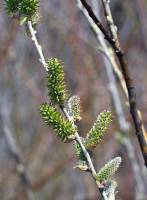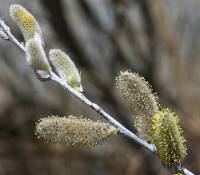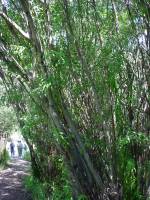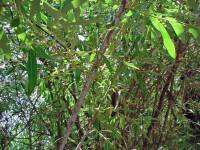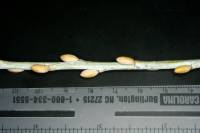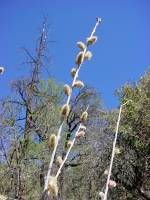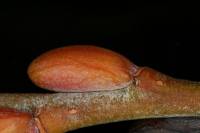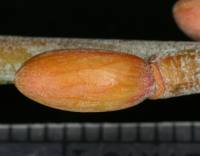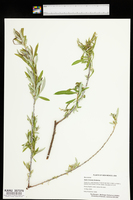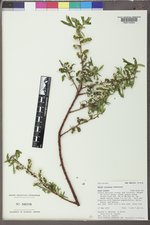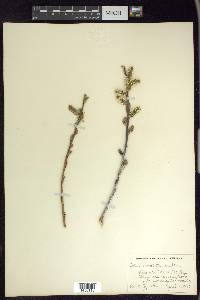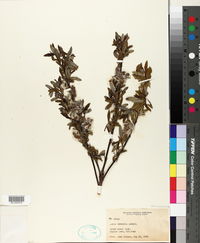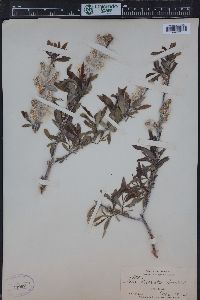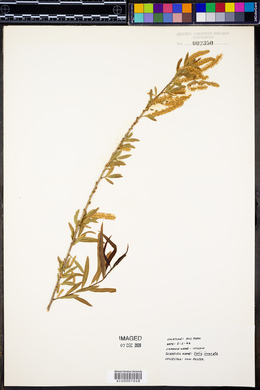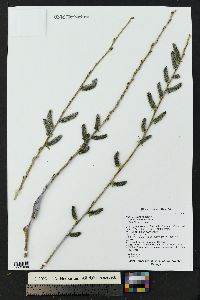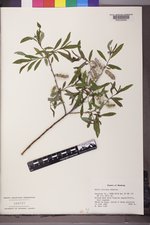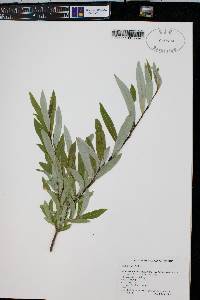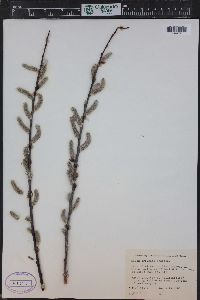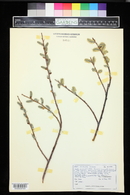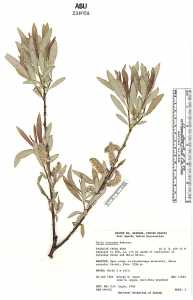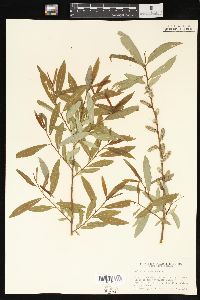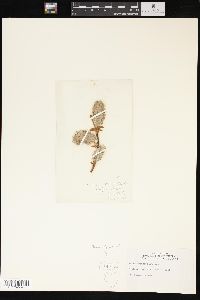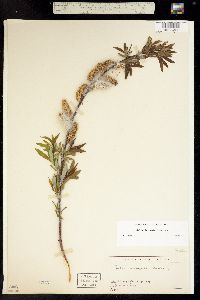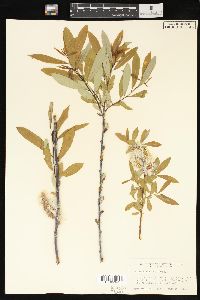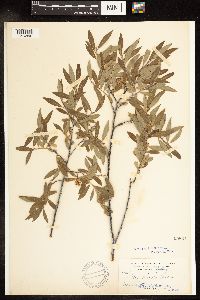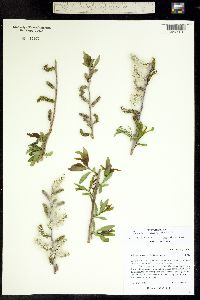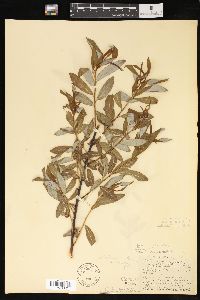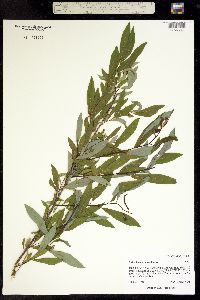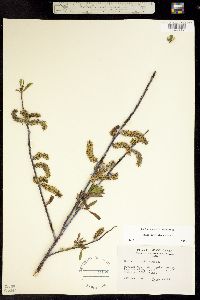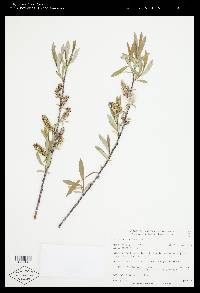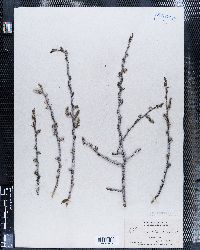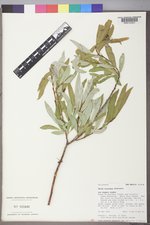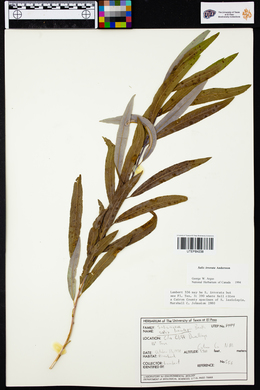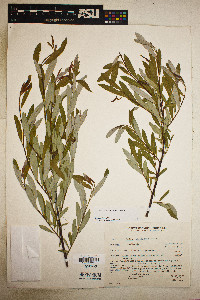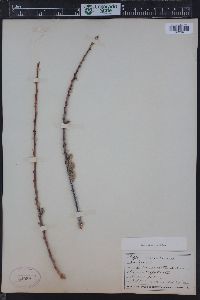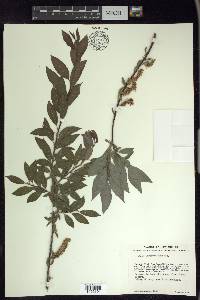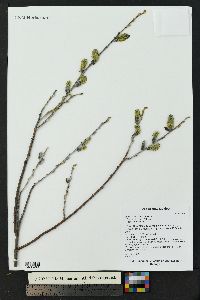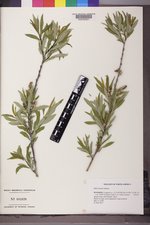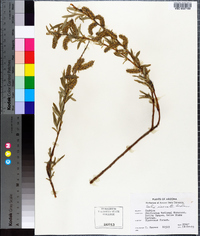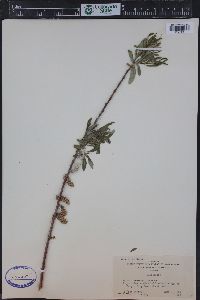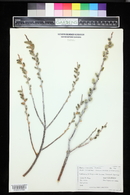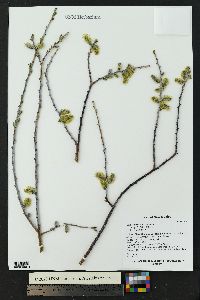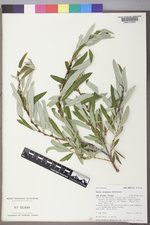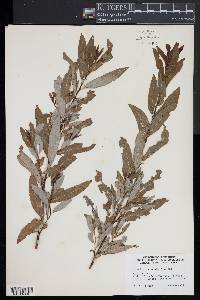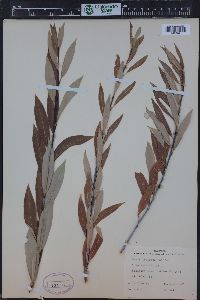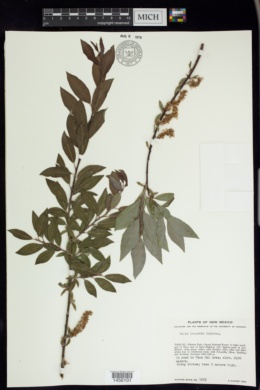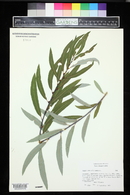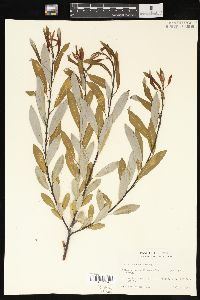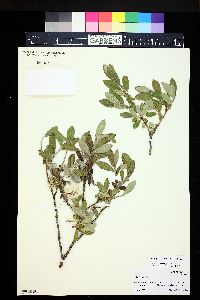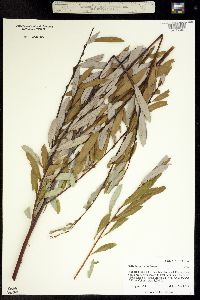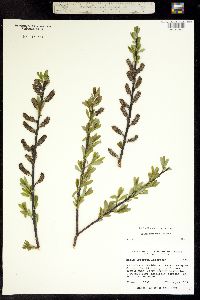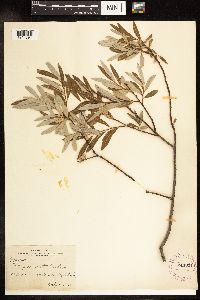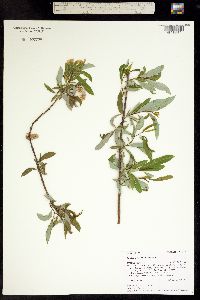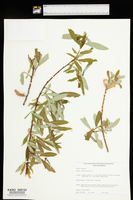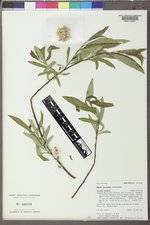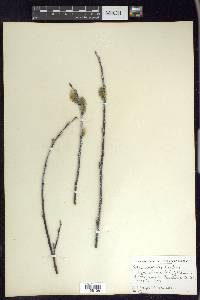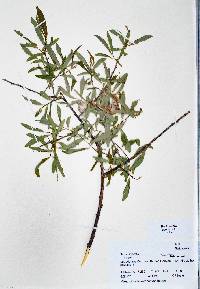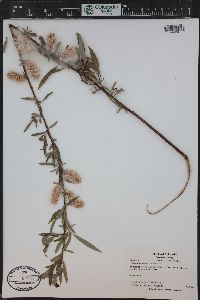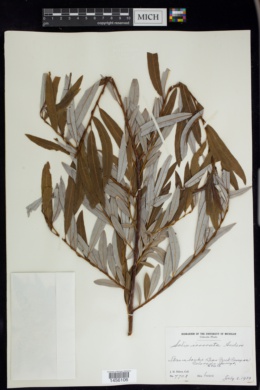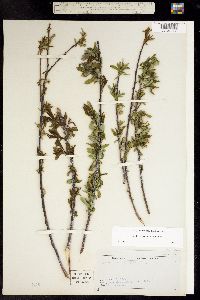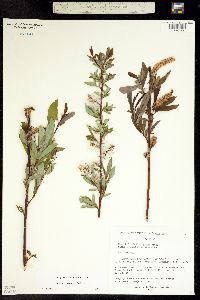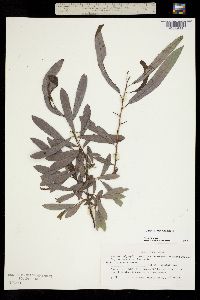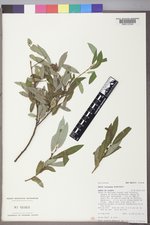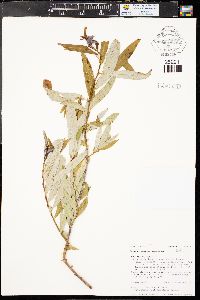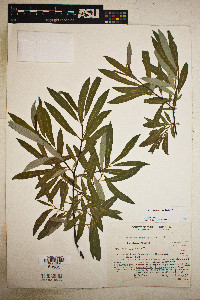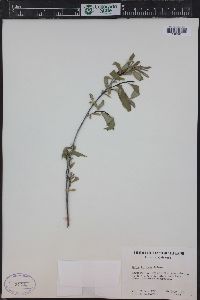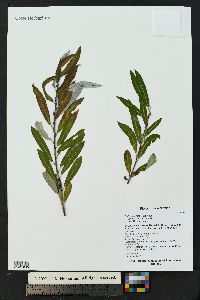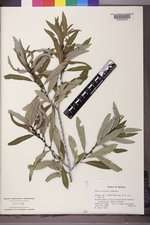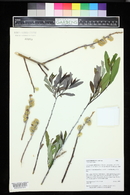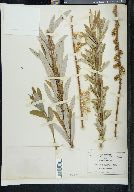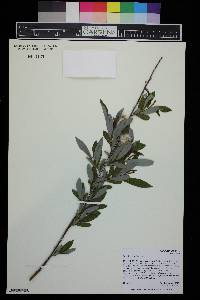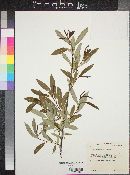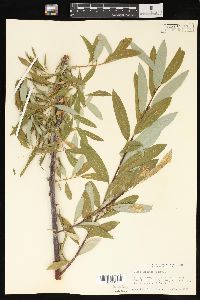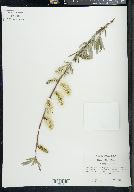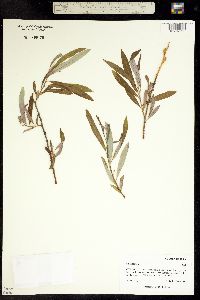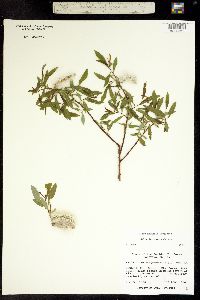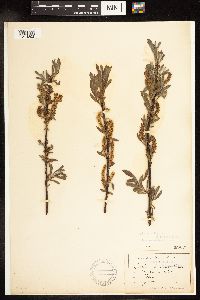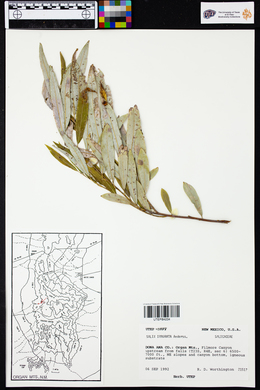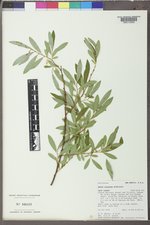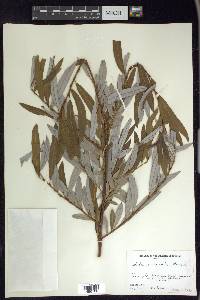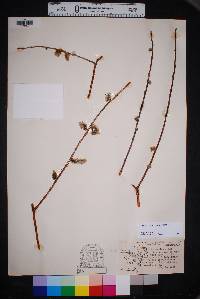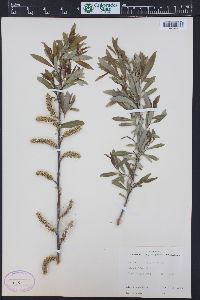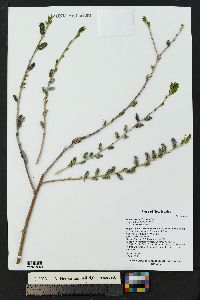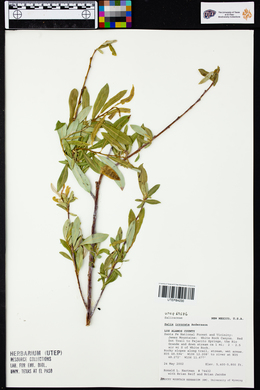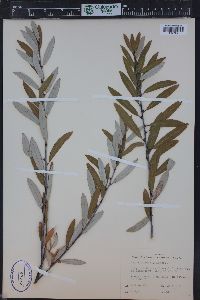
|
|
|
|
Family: Salicaceae
Dewy-Stem Willow, more...dewystem willow, bluestem willow, sandbar willow
|
Shrubs, 2-7 m, (multistemmed, sometimes forming clones by stem fragmentation). Stems: branches (highly brittle or not at base), red-brown to violet, usually glaucous, glabrous; branchlets yellow-brown, (strongly glaucous or not), glabrous, sparsely velvety, or tomentose. Leaves: stipules absent or rudimentary on early ones, foliaceous or rudimentary on late ones, apex acute; petiole convex to flat adaxially, 4-14 mm, velvety adaxially; largest medial blade lorate, narrowly oblong, narrowly elliptic, or narrowly oblanceolate, 47-115 × 8-22 mm, 3.5-7.7 times as long as wide, base cuneate or convex, margins flat to slightly revolute, entire and gland-dotted, serrulate or crenate, apex acuminate, acute, or convex, abaxial surface glaucous, glabrous, sparsely tomentose, or short-silky, hairs wavy, adaxial slightly to highly glossy, glabrous or pilose; proximal blade margins entire or serrulate; juvenile blade yellowish green or reddish, glabrous or sparsely villous abaxially, hairs white. Catkins flowering before or just before leaves emerge; staminate stout or subglobose, 15-34 × 8-22 mm, flowering branchlet 0(-2) mm; pistillate densely flowered, stout or slender, 14-43 × 7-12 mm, flowering branchlet 0-4 mm; floral bract brown or black, 1.3-2.5 mm, apex rounded, abaxially hairy, hairs straight or wavy. Staminate flowers: adaxial nectary narrowly oblong to oblong, 0.3-0.8 mm; filaments connate less than to more than 1/2 their lengths; anthers yellow or purple turning yellow, ellipsoid or shortly cylindrical, 0.4-0.7 mm. Pistillate flowers: adaxial nectary narrowly oblong to oblong, 0.3-0.7 mm; stipe 0.4-1 mm; ovary pyriform, beak slightly bulged below styles; ovules 9-12 per ovary; styles 0.3-0.9 mm; stigmas flat, abaxially non-papillate with rounded tip, 0.15-0.28-0.6 mm. Capsules 3.5-4 mm. 2n = 38. Flowering mid Mar-mid May. Streams, wet meadows; 1400-3000 m; Ariz., Colo., N.Mex., Wyo.; Mexico (Baja California, Chihuahua, Coahuila, Durango, Sonora). Salix irrorata is very closely related to S. lasiolepis. The two are here maintained as separate species primarily because S. irrorata is a diploid and S. lasiolepis a tetraploid, and also because of their largely allopatric ranges (G. W. Argus 2007). Studies of sawflies (Euura Newman) by P. W. Price (pers. comm.) show that the same species of Euura can successfully reproduce on either willow. The only morphological character that separates the two is that in S. irrorata branchlets and branches are very strongly glaucous, whereas in S. lasiolepis they are not glaucous. Some plants have weakly glaucous stems (wax not visible except by polishing or only as sparkling crystals); this may be infraspecific variability or evidence of hybridization. Hybrids: Salix irrorata forms natural hybrids with S. drummondiana, S. geyeriana, and S. lasiolepis var. lasiolepis. Salix irrorata × S. lasiolepis var. lasiolepis: This putative hybrid occurs in Arizona and New Mexico. It is characterized mainly by weakly glaucous branches.
Plant: shrub; to 7 m tall; branches highly brittle to flexible at base, red-brown to violet, thickly glaucous, glabrous; branchlets yellow-brown, glabrous, tomentose, or velvety becoming glabrous Leaves: stipules absent to leaflike; petioles velvety, 4-14 mm long; proximal leaves on vegetative or flowering branchlets entire or glandular-dotted; young leaves glabrous or villous; mature blade ligulate to narrowly oblong, narrowly elliptic, or narrowly oblanceolate, 47-115 mm long, 8-22 mm wide, 3.5-7.7 times as long as wide, the lower surface glaucous, glabrous, sparsely tomentose, or short silky becoming glabrous, the upper surface shiny or highly glossy, glabrous or pilose, the base cuneate to acute, the margins slightly revolute to flat, entire, gland-dotted, or remotely and irregularly serrate (undulating), with 2-7 teeth or glands per cm, the apex acute to acuminate or obtuse INFLORESCENCE: cylindrical to subspherical catkins; precocious or subprecocious; catkins sessile, rarely on flowering branchlets to 5 mm long; floral bracts dark brown to black, 1.3-2.5 mm long, with straight or wavy hairs, the apices rounded Flowers: STAMINATE FLOWERS in densely flowered catkins 18-30 mm long; filaments glabrous; nectary slender to broad, 0.3-0.7 mm long. PISTILLATE FLOWERS in densely flowered catkins 18-42 mm long; ovaries glabrous; stigmas 0.15-0.6 mm long; styles 0.3-0.9 mm long; stipes 0.7-1.2 mm long; nectary slender to broad, 0.32-0.6 mm long, shorter than stipe Fruit: lanceolate to ovate Misc: thickets along rivers and creeks, and wet meadows; 1450-3000 m (4500-9200 ft); Apr-May REFERENCES: Argus, George W. 1995. SalicaceaePart 2. Salix. J. Ariz. - Nev. Acad. Sci. 29(1): 39 Argus 1995, Martin and Hutchins 1980 Common Name: dewystem willow Duration: Perennial Nativity: Native Lifeform: Shrub Wetland Status: FACW General: Shrubby with brittle to flexible branches at base, these red-brown to violet but thickly glaucous, branchlets yellow-brown, tomentose or velvety but becoming glabrous. Leaves: On velvety petioles 4-14 mm long, blade narrowly oblong to narrowly elliptic or oblanceolate, 5-11.5 cm long, 8-22 mm wide, 3-7 times as long as wide, lower surface glaucous, sparsely tomentose, upper surface shiny or highly glossy, base cuneate to acute, margins slightly revolute to flat, entire, gland-dotted, with 2-7 teeth or glands per cm, apex acute to acuminate or obtuse. Flowers: Sessile catkins, to 5 mm long, floral bracts dark brown to black, 1-2.5 mm long, straight to wavy hairs; anthers reddish at the apex; scales ovate to obovate, drying black, long-pilose; both staminate and pistillate flowers in densely lowered catkins, staminate 18-30 mm long, pistillate 18-42 mm long. Fruits: Ovoid capsules, glabrous, 3-4 mm long Ecology: Found in thickets along streams from 4,500-9,000 ft (1372-2743 m); flowers April-May. Notes: Midway in size between S. exigua and S. gooddingii, this species is distinguished by the bluish-whitish powdery cast on the stems. Ethnobotany: Used to make baskets and water jugs, for building materials, prayer sticks, cooking tools, and used in games. Etymology: Salix is the Latin name for willow, meaning -to leap or spring-, while irrorata is uncertain, but is thought to mean dewy. Synonyms: None Editor: SBuckley, 2010 |
|
|
|
This project was made possible in part by the Institute of Museum and Library Services [MG-70-19-0057-19].
Powered by Symbiota


